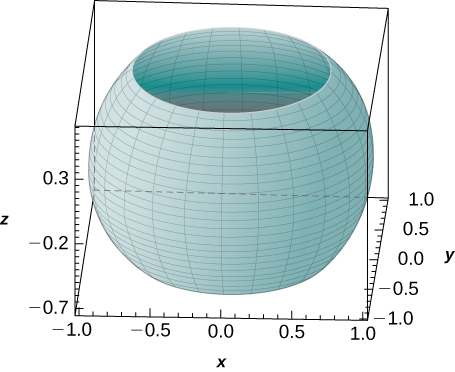9.5E: Excersies
( \newcommand{\kernel}{\mathrm{null}\,}\)
Exercise 9.5E.1
In the following exercises, evaluate the triple integrals ∭Ef(x,y,z)dV over the solid E.
1.
f(x,y,z)=z,B={(x,y,z)|x2+y2≤9,x≤0,y≤0,0≤z≤1}
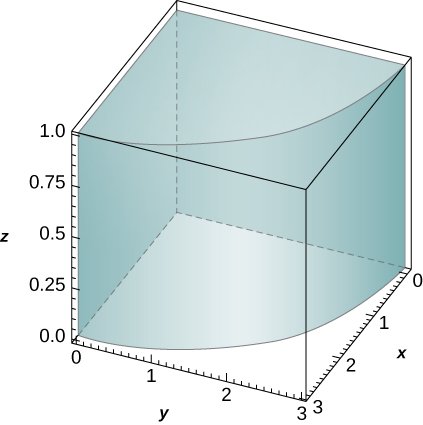
- Answer
- 9π8
2. f(x,y,z)=xz2, B={(x,y,z)|x2+y2≤16, x≥0, y≤0, −1≤z≤1}
3.
f(x,y,z)=xy, B={(x,y,z)|x2+y2≤1, x≥0, x≥y, −1≤z≤1}
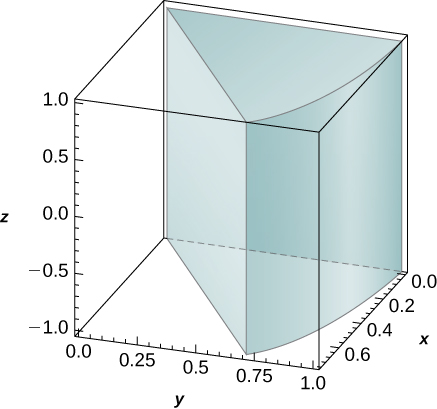
- Answer
- 18
4. f(x,y,z)=x2+y2, B={(x,y,z)|x2+y2≤4, x≥0, x≤y, 0≤z≤3}
5. f(x,y,z)=e√x2+y2, B={(x,y,z)|1≤x2+y2≤4, y≤0, x≤y√3, 2≤z≤3}
- Answer
-
πe26
6. f(x,y,z)=√x2+y2, B={(x,y,z)|1≤x2+y2≤9, y≤0, 0≤z≤1}
Exercise 9.5E.2
7.
a. Let B be a cylindrical shell with inner radius a outer radius b, and height c where 0<a<b and c>0. Assume that a function F defined on B can be expressed in cylindrical coordinates as F(x,y,z)=f(r)+h(z), where f and h are differentiable functions. If ∫baˉf(r)dr=0 and ˉh(0)=0, where ˉf and ˉh are antiderivatives of f and h, respectively, show that
∭BF(x,y,z)dV=2πc(bˉf(b)−aˉf(a))+π(b2−a2)ˉh(c).
b. Use the previous result to show that
∭B(z+sin√x2+y2)dx dy dz=6π2(π−2),
where B is a cylindrical shell with inner radius π outer radius 2π, and height 2.
8.
a. Let B be a cylindrical shell with inner radius a outer radius b and height c where 0<a<b and c>0. Assume that a function F defined on B can be expressed in cylindrical coordinates as F(x,y,z) = f(r) g(\theta) f(z)\), where f, g, and h are differentiable functions. If ∫ba˜f(r)dr=0, where ˜f is an antiderivative of f, show that
∭BF(x,y,z)dV=[b˜f(b)−a˜f(a)][˜g(2π)−˜g(0)][˜h(c)−˜h(0)],
where ˜g and ˜h are antiderivatives of g and h, respectively.
b. Use the previous result to show that ∭Bz sin√x2+y2dx dy dz=−12π2, where B is a cylindrical shell with inner radius π outer radius 2π, and height 2.
Exercise 9.5E.3
In the following exercises, the boundaries of the solid E are given in cylindrical coordinates.
a. Express the region E in cylindrical coordinates.
b. Convert the integral ∭Ef(x,y,z)dV to cylindrical coordinates.
9. E is bounded by the right circular cylinder r=4 sin θ, the rθ-plane, and the sphere r2+z2=16.
- Answer
-
a. E={(r,θ,z)|0≤θ≤π, 0≤r≤4 sin θ, 0≤z≤√16−r2}
b. ∫π0∫4 sin θ0∫√16−r20f(r,θ,z)r dz dr dθ
10. E is bounded by the right circular cylinder r=cos θ, the rθ-plane, and the sphere r2+z2=9.
11. E is located in the first octant and is bounded by the circular paraboloid z=9−3r2, the cylinder r=√r, and the plane r(cos θ+sin θ)=20−z.
- Answer
-
a. \(E = \{(r,\theta,z) |0 \leq \theta \leq \frac{\pi}{2}, \space 0 \leq r \leq \sqrt{3}, \space 9 - r^2 \leq z \leq 10 - r(cos \space \theta + sin \space \theta)\};
b. ∫π/20∫√30∫10−r(cos θ+sin θ)9−r2f(r,θ,z)r dz dr dθ
12. E is located in the first octant outside the circular paraboloid z=10−2r2 and inside the cylinder r=√5 and is bounded also by the planes z=20 and θ=π4.
Exercise 9.5E.4
The following exercises give the function f and region E.
a. Express the region E and the function f in cylindrical coordinates.
b. Convert the integral ∭Bf(x,y,z)dV into cylindrical coordinates and evaluate it.
13. f(x,y,z)=x2+y2, E={(x,y,z)|0≤x2+y2≤9, x≥0, y≥0, 0≤z≤x+3}
- Answer
-
a. E={(r,θ,z)|0≤r≤3, 0≤θ≤π2, 0≤z≤r cos θ+3}, f(r,\theta,z) = \frac{1}{r \space cos \space \theta + 3};
b. ∫30∫π/20∫r cos θ+30rr cos θ+3dz dθ dr=9π4
14. f(x,y,z)=x2+y2, E={(x,y,z)|0≤x2+y2≤4, y≥0, 0≤z≤3−x
15. f(x,y,z)=x, E={(x,y,z)|1≤y2+z2≤9, 0≤x≤1−y2−z2}
- Answer
-
a. y=r cos θ, z=r sin θ, x=z, E={(r,θ,z)|1≤r≤3, 0≤θ≤2π, 0≤z≤1−r2}, f(r,θ,z)=z;
b. ∫31∫2π0∫1−r20zr dz dθ dr=356π3
16. f(x,y,z)=y, E={(x,y,z)|1≤x2+z2≤9, 0≤y≤1−x2−z2}
Exercise 9.5E.5
In the following exercises, find the volume of the solid E whose boundaries are given in rectangular coordinates.
17. E is above the xy-plane, inside the cylinder x2+y2=1, and below the plane z=1.
- Answer
-
π
18. E is below the plane z=1 and inside the paraboloid z=x2+y2.
19. E is bounded by the circular cone z=√x2+y2 and z=1.
- Answer
-
π3
20. E is located above the xy-plane, below z=1, outside the one-sheeted hyperboloid x2+y2−z2=1, and inside the cylinder x2+y2=2.
21. E is located inside the cylinder x2+y2=1 and between the circular paraboloids z=1−x2−y2 and z=x2+y2.
- Answer
-
π
22. E is located inside the sphere x2+y2+z2=1, above the xy-plane, and inside the circular cone z=√x2+y2.
23. E is located outside the circular cone x2+y2=(z−1)2 and between the planes z=0 and z=2.
- Answer
-
4π3
24. E is located outside the circular cone z=1−√x2+y2, above the xy-plane, below the circular paraboloid, and between the planes z=0 and z=2.
Exercise 9.5E.6
25. [T] Use a computer algebra system (CAS) to graph the solid whose volume is given by the iterated integral in cylindrical coordinates ∫π/2−π/2∫10∫rr2rdzdrdθ. Find the volume V of the solid. Round your answer to four decimal places.
- Answer
-
V=pi12≈0.2618
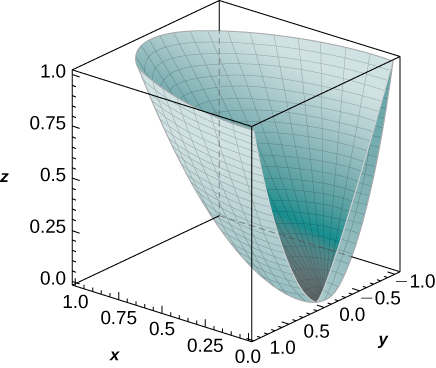
26. [T] Use a CAS to graph the solid whose volume is given by the iterated integral in cylindrical coordinates ∫π/20∫10∫rr4rdzdrdθ. Find the volume E of the solid. Round your answer to four decimal places.
Exercise 9.5E.7
27. Convert the integral ∫10∫√1−y2−√1−z2∫√x2+y2x2+y2xz dz dx dy into an integral in cylindrical coordinates.
- Answer
-
\[\int_0^1 \int_0^{\pi} \int_{r^2}^r zr^2 \space cos \space \theta \space dz \space d\theta \space dr\
28. Convert the integral ∫20∫x0∫10(xy+z)dz dx dy into an integral in cylindrical coordinates.
Exercise 9.5E.8
In the following exercises, evaluate the triple integral ∭Bf(x,y,z)dV over the solid B.
29. f(x,y,z)=1, B={(x,y,z)|x2+y2+z2≤90, z≥0}
30. f(x,y,z)=1, B={(x,y,z)|x2+y2+z2≤90, z≥0}
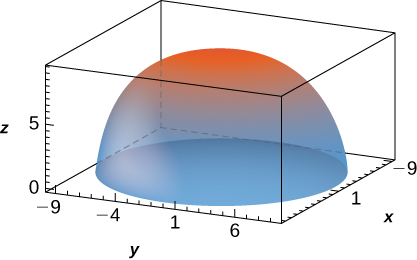
[Hide Solution]
- Answer
- 180π√10
31. f(x,y,z)=1−√x2+y2+z2, B={(x,y,z)|x2+y2+z2≤9, y≥0, z≥0}
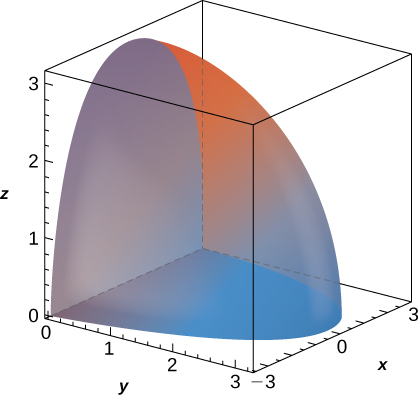
32. f(x,y,z)=√x2+y2, B is bounded above by the half-sphere x2+y2+z2=9 with z≥0 and below by the cone 2z2=x2+y2.
- Answer
- 81π(π−2)16
33. f(x,y,z)=√x2+y2, B is bounded above by the half-sphere x2+y2+z2=16 with z≥0 and below by the cone 2z2=x2+y2.
Exercise 9.5E.9
34. Show that if F(ρ,θ,φ)=f(ρ)g(θ)h(φ) is a continuous function on the spherical box B={(ρ,θ,φ)|a≤ρ≤b, α≤θ≤β, γ≤φ≤ψ}, then ∭BF dV=(∫baρ2f(ρ) dr)(∫βαg(θ) dθ)(∫ψγh(φ) sinφ dφ).
35. A function F is said to have spherical symmetry if it depends on the distance to the origin only, that is, it can be expressed in spherical coordinates as F(x,y,z)=f(ρ), where ρ=√x2+y2+z2. Show that ∭BF(x,y,z)dV=2π∫baρ2f(ρ)dρ, where B is the region between the upper concentric hemispheres of radii a and b centered at the origin, with 0<a<b and F a spherical function defined on B.
Use the previous result to show that ∭B(x2+y2+z2)√x2+y2+z2dV=21π, where B={(x,y,z)|1≤x2+y2+z2≤2, z≥0}.
36. Let B be the region between the upper concentric hemispheres of radii a and b centered at the origin and situated in the first octant, where 0<a<b. Consider F a function defined on B whose form in spherical coordinates (ρ,θ,φ) is F(x,y,z)=f(ρ)cosφ. Show that if g(a)=g(b)=0 and ∫bah(ρ)dρ=0, then ∭BF(x,y,z)dV=π24[ah(a)−bh(b)], where g is an antiderivative of f and h is an antiderivative of g.
Use the previous result to show that ∭B=zcos√x2+y2+z2√x2+y2+z2dV=3π22, where B is the region between the upper concentric hemispheres of radii π and 2π centered at the origin and situated in the first octant.
Exercise \PageIndex{10}
The following exercises give the function f and region E.
a. Express the region E and function f in cylindrical coordinates.
b. Convert the integral \iiint_B f(x,y,z)dV into cylindrical coordinates and evaluate it.
37. f(x,y,z) = z; \space E = \{(x,y,z) | 0 \leq x^2 + y^2 + z^2 \leq 1, \space z \geq 0\}
38. f(x,y,z) = x + y; \space E = \{(x,y,z) | 1 \leq x^2 + y^2 + z^2 \leq 2, \space z \geq 0, \space y \geq 0\}
- Answer
-
a. f(\rho,\theta, \varphi) = \rho \space sin \space \varphi \space (cos \space \theta + sin \space \theta), \space E = \{(\rho,\theta,\varphi) | 1 \leq \rho \leq 2, \space 0 \leq \theta \leq \pi, \space 0 \leq \varphi \leq \frac{\pi}{2}\};
b. \int_0^{\pi} \int_0^{\pi/2} \int_1^2 \rho^3 cos \space \varphi \space sin \space \varphi \space d\rho \space d\varphi \space d\theta = \frac{15\pi}{8}
39. f(x,y,z) = 2xy; \space E = \{(x,y,z) | \sqrt{x^2 + y^2} \leq z \leq \sqrt{1 - x^2 - y^2}, \space x \geq 0, \space y \geq 0\}
40. f(x,y,z) = z; \space E = \{(x,y,z) | x^2 + y^2 + z^2 - 2x \leq 0, \space \sqrt{x^2 + y^2} \leq z\}
- Answer
-
a. f(\rho,\theta,\varphi) = \rho \space cos \space \varphi; \space E = \{(\rho,\theta,\varphi) | 0 \leq \rho \leq 2 \space cos \space \varphi, \space 0 \leq \theta \leq \frac{\pi}{2}, \space 0 \leq \varphi \leq \frac{\pi}{4}\};
b. \int_0^{\pi/2} \int_0^{\pi/4} \int_0^{2 \space cos \space \varphi} \rho^3 sin \space \varphi \space cos \space \varphi \space d\rho \space d\varphi \space d\theta = \frac{7\pi}{24}
Exercise \PageIndex{11}
In the following exercises, find the volume of the solid E whose boundaries are given in rectangular coordinates.
41. E = \{ (x,y,z) | \sqrt{x^2 + y^2} \leq z \leq \sqrt{16 - x^2 - y^2}, \space x \geq 0, \space y \geq 0\}
42. E = \{ (x,y,z) | x^2 + y^2 + z^2 - 2z \leq 0, \space \sqrt{x^2 + y^2} \leq z\}
- Answer
-
\frac{\pi}{4}
43. Use spherical coordinates to find the volume of the solid situated outside the sphere \rho = 1 and inside the sphere \rho = cos \space \varphi, with \varphi \in [0,\frac{\pi}{2}].
44. Use spherical coordinates to find the volume of the ball \rho \leq 3 that is situated between the cones \varphi = \frac{\pi}{4} and \varphi = \frac{\pi}{3}.
- Answer
-
9\pi (\sqrt{2} - 1)
45. Convert the integral
\int_{-4}^4 \int_{-\sqrt{16-y^2}}^{\sqrt{16-y^2}} \int_{-\sqrt{16-x^2-y^2}}^{\sqrt{16-x^2-y^2}} (x^2 + y^2 + z^2) \, dz \, dx \, dy\) into an integral in spherical coordinates.
46. Convert the integral \displaystyle \int_0^4 \int_0^{\sqrt{16-x^2}} \int_{-\sqrt{16-x^2-y^2}}^{\sqrt{16-x^2-y^2}} (x^2 + y^2 + z^2)^2 \, dz \space dy \space dx into an integral in spherical coordinates.
- Answer
- \displaystyle\int_0^{\pi/2} \int_0^{\pi/2} \int_0^4 \rho^6 \sin \varphi \, d\rho \, d\phi \, d\theta
Contributors
Gilbert Strang (MIT) and Edwin “Jed” Herman (Harvey Mudd) with many contributing authors. This content by OpenStax is licensed with a CC-BY-SA-NC 4.0 license. Download for free at http://cnx.org.


